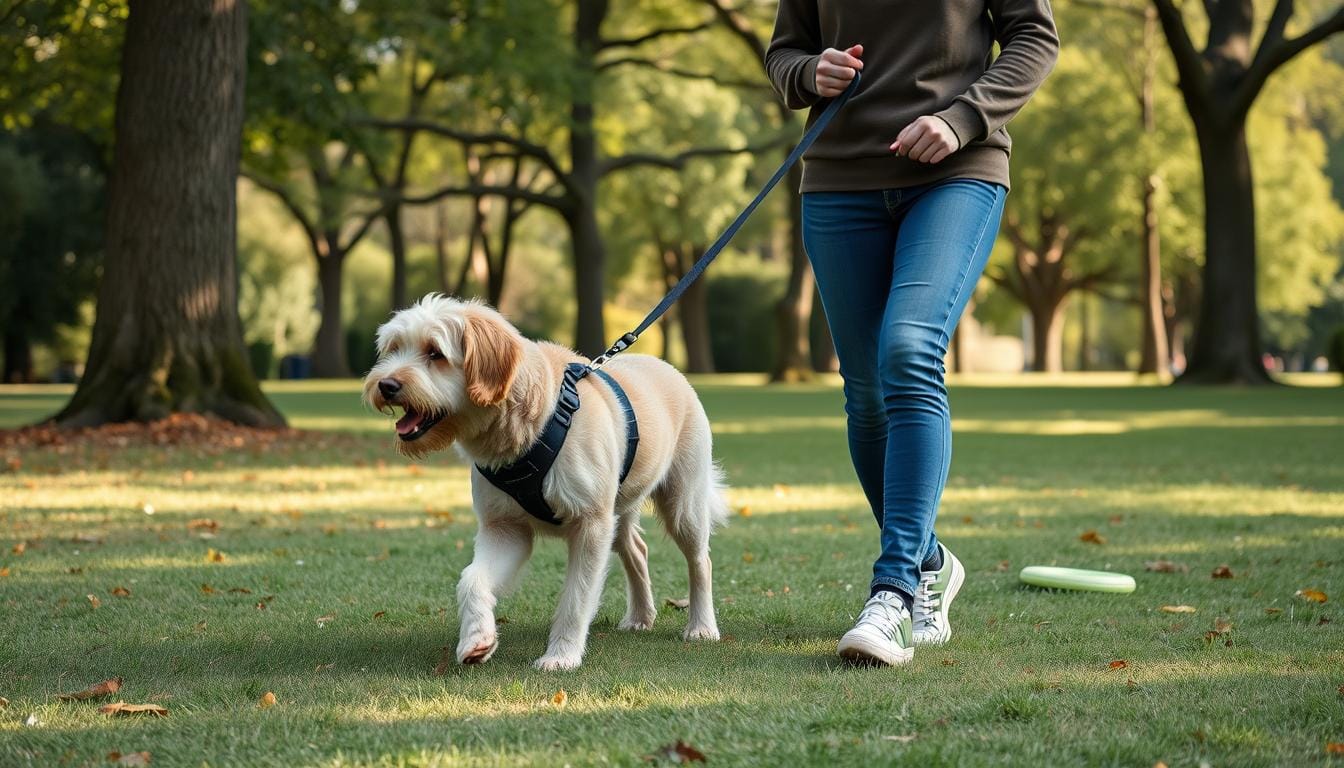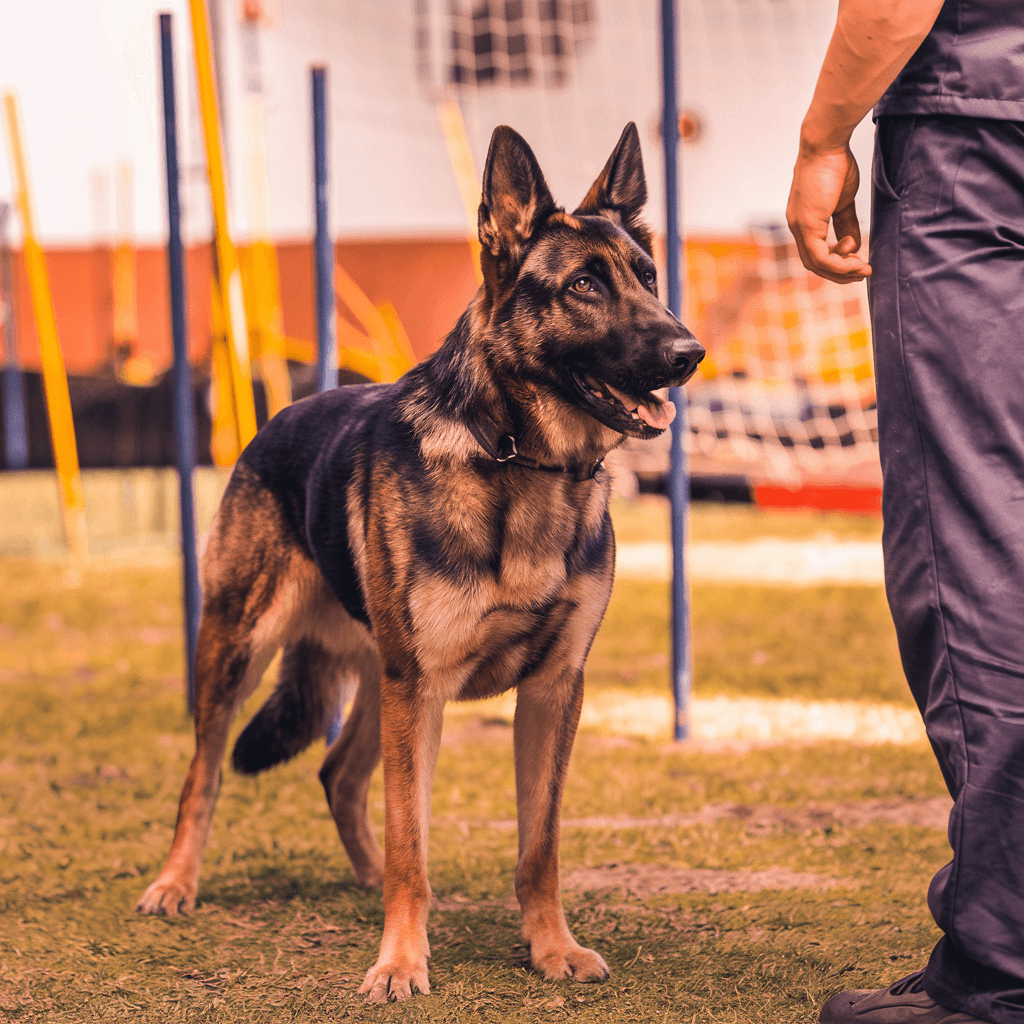What makes Golden Retrievers so special? They are loved worldwide for their friendly nature and beautiful golden coats. Did you know they were first bred in Scotland by Lord Tweedmouth in the 1800s? This history is just the start of why they’re so unique.
Golden Retrievers are more than just good-looking family dogs. They are smart, versatile, and can do many jobs. They help the blind and are great hunting dogs. Their friendly and adaptable nature has made them a favorite in America for many years.
Join us as we explore the world of Golden Retrievers. From their Scottish beginnings to being beloved family pets, there’s much to learn. Let’s discover what makes Golden Retrievers such amazing dogs and why they could be perfect for your family.
Key Takeaways
- Golden Retrievers originated in Scotland in the 1800s
- They are consistently ranked among America’s most popular dog breeds
- Golden Retrievers are versatile, excelling as family pets and working dogs
- These dogs are known for their friendly temperament and intelligence
- Golden Retrievers require regular exercise and grooming
- They are adaptable to various living environments
- Golden Retrievers have a lifespan of 10 to 12 years
The History and Origin of Golden Retrievers
The story of Golden Retrievers starts in the Scottish Highlands. This breed’s history goes back to the mid-1800s. A Scottish nobleman wanted to create the perfect hunting dog.
Scottish Roots: Lord Tweedmouth’s Vision
In 1865, Lord Tweedmouth bought a Yellow Retriever named “Nous.” This was the start of a breeding plan. He mixed Nous with a Tweed Water Spaniel named Belle. This mix became the Golden Retriever breed.
Early Development and Breeding Goals
Lord Tweedmouth kept detailed records of his breeding in a leather book. This book is now at the Kennel Club in England. He aimed to create a dog that could retrieve game gently but also be strong and active.
Introduction to America and Rising Popularity
Golden Retrievers arrived in North America in 1895. Lord Tweedmouth’s son brought two dogs: Sol to Texas and Lady to Canada. The breed was recognized by the Kennel Club in 1913. It quickly became popular worldwide, especially in the U.S. by 1932.
Today, Golden Retrievers are among the top dog breeds in the U.S. They are known for their smarts, gentle nature, and loyalty.
Physical Characteristics of Golden Retrievers
Golden Retrievers are loved for their golden retriever appearance and friendly nature. They are medium to large dogs with a sturdy build and athletic look. This reflects their hunting background. Let’s look at what makes Golden Retrievers special.
Size and Weight
Golden Retrievers show a difference in size between males and females:
- Males: 23-24 inches tall, weighing 65-75 pounds
- Females: 21.5-22.5 inches tall, weighing 55-65 pounds
Coat Color and Texture
Their double coat is a key feature. The outer layer is water-repellent and slightly wavy. The undercoat is soft and dense. Their coat color can range from light gold to deep golden, with slight variations.
Distinctive Features
Golden Retrievers are known for their:
- Broad, well-proportioned head
- Friendly, expressive eyes
- Feathered tail, often wagging happily
- Strong, muscular body with good balance
These traits make Golden Retrievers charming and functional. Their sturdy build and water-resistant coat make them great swimmers and retrievers. They are true to their hunting roots.
| Trait | Level |
|---|---|
| Affection | High |
| Kid-Friendly | High |
| Exercise Needs | High |
| Intelligence | High |
| Shedding | High |
Knowing these physical traits helps future owners prepare for their care. Golden Retrievers are a joy but need dedication and love to flourish.
Golden Retriever Temperament and Personality
Golden Retrievers are known for their gentle and friendly nature. They have a special temperament that makes them great family pets. Their outgoing and confident personalities make them a pleasure to be around.
Golden Retrievers are very sociable. They are the third most popular dog breed in America, thanks to the American Kennel Club. Their loving nature and ability to bond with humans make them popular family pets.
Golden Retrievers are patient and kind. These traits make them perfect for families with children and other pets. They are known for being gentle, which sets them apart from many other breeds.
- Highly intelligent and quick learners
- Patient and gentle, especially with children
- Outgoing and friendly towards strangers
- Eager to please and highly trainable
Golden Retrievers love being around people and need lots of attention. Their playful nature stays with them into adulthood, keeping families happy for years. With the right training and socialization, they become wonderful companions.
“A Golden Retriever’s heart is made of gold, and their personality shines just as brightly.”
Golden Retrievers are smart and love to please, making them great working dogs. They are often used as therapy dogs, guide dogs, and assistance dogs. This shows how adaptable their temperament is in different roles and settings.
Training and Exercise Needs
Golden Retrievers are full of energy and love to stay active. They also enjoy solving puzzles and learning new things. We’ll look at how much exercise they need and share tips for training them.
Mental Stimulation Requirements
Golden Retrievers get bored easily and might start to chew on things they shouldn’t. Giving them puzzle toys and teaching them tricks keeps their minds sharp. Training during walks helps them listen and keeps them mentally active.

Physical Exercise Recommendations
Adult Golden Retrievers need 20-30 minutes of playtime twice a day. They love going on hikes, swimming, or playing fetch. Puppies need 5 minutes of playtime for every month of their age. As they get older, they need less intense activities.
Training Tips and Best Practices
Start training your Golden Retriever early. Take them to dog parks to help them get used to different places. Positive rewards work best with this breed. Make sure to adjust their exercise based on their age and energy level.
| Age Group | Exercise Duration | Recommended Activities |
|---|---|---|
| Puppies | 5 min per month of age | Short walks, gentle play |
| Adults | 40-120 min daily | Hiking, swimming, fetch |
| Seniors (8+ years) | Adapted routine | Gentle walks, low-impact activities |
Meeting your Golden Retriever’s exercise needs helps them feel less stressed and anxious. Regular activities and mental challenges keep them happy and well-behaved.
Grooming and Care for Your Golden Retriever
Golden retriever care means regular grooming to keep their coats beautiful and healthy. These dogs shed a bit all year, but more heavily a few times a year. Daily brushing with a pin brush is key to manage their hair and keep your home clean.
For regular dog grooming, a weekly brush is enough. But if your Golden does therapy work, they need more grooming. Bathe them every few months with good dog shampoo and conditioner. After a bath, dry them gently or use a dog hairdryer for faster drying.
Don’t forget about nail care. Trim their nails monthly, or weekly if they’re show dogs. Also, clip the hair between their paw pads for better grip on slippery floors. Regular ear checks are important, especially for water-loving Goldens, to prevent infections. Lastly, keep up with flea prevention to avoid allergies and hot spots.
- Brush coat daily during heavy shedding periods
- Bathe every few months with quality canine products
- Trim nails monthly and check ears weekly
- Maintain a flea prevention routine
By sticking to these grooming tips, your Golden Retriever will stay healthy, comfortable, and look great. Regular grooming also helps catch health problems early, keeping your furry friend happy and well.
Health Concerns and Common Medical Issues
Golden retriever health is key for any pet owner. These dogs face several health problems that need care. Knowing about these issues helps owners give their pets the best care.
Genetic Predispositions
Golden Retrievers have genetic health issues. Cancer is a big worry, with about 60% of deaths from it. They can also get hip and elbow dysplasia, hypothyroidism, and eye problems like glaucoma and cataracts.
Preventative Care Measures
Preventive steps can help a lot. Regular exercise, a balanced diet, and keeping a healthy weight are important. Responsible breeding and early treatment of problems like glaucoma can also help.

Regular Health Screenings
Regular vet visits are crucial. Insurance data shows over 5,000 claims for checkups, costing an average of $398.51. X-rays average $764.72 per claim. Screenings should include:
- Cancer screenings
- Joint evaluations
- Eye examinations
- Thyroid function tests
- Skin health checks
By being aware of these issues, Golden Retriever owners can help their pets stay healthy and happy.
Nutrition and Dietary Requirements
Golden Retriever diet is key to their health and energy. Adult Golden Retrievers should eat about two cups of top-notch dog food each day. This is divided into two meals to avoid overeating and weight problems.
Quality is essential in dog nutrition. Bad diets can cause expensive skin issues and vet visits. Stay away from foods with animal digest, artificial colors, or too much salt. Choose human-grade meat-based ingredients and natural preservatives like Vitamins C and E.
Golden Retrievers need a balanced diet with protein, carbs, vitamins, and minerals. Protein is vital for muscle growth and repair. A diet full of antioxidants and omega fatty acids keeps their skin and fur healthy.
- Avoid grains like corn and soy, which can cause skin issues
- Be cautious with grain-free foods high in carbohydrates
- Choose large-breed formulas for proper nutritional balance
Every Golden Retriever’s diet needs are different, based on age, weight, and health. Always talk to a vet to find the best diet for your dog.
Golden Retrievers as Family Pets
Golden Retrievers are the third most popular breed in the U.S., according to a 2021 study. They are known as the perfect family dog. Let’s see why they make great companions and fit well with other pets.
Interaction with Children
Golden Retrievers are patient and gentle with kids. They love to play and learn tricks, making them fun for children. But, it’s important to watch them closely, especially with little kids, as they can accidentally knock them over.
Compatibility with Other Pets
Golden Retrievers get along well with other pets. They are social and love attention, making them great for homes with multiple pets. Early socialization helps them have good interactions with other animals.
Adaptability to Different Living Environments
Golden Retrievers fit into different homes, but they need space. They need a big yard or lots of walks and playtime. They don’t do well living outside and love being part of the family indoors.
| Characteristic | Male Golden Retriever | Female Golden Retriever |
|---|---|---|
| Height | 23-24 inches | 21.5-22.5 inches |
| Weight | 65-75 pounds | 55-65 pounds |
| Life Expectancy | 10-12 years | |
| Exercise Needs | High (daily exercise required) | |
| Trainability | Excellent (eager to please) | |
Getting a Golden Retriever is a big commitment. They need lots of care, exercise, and training. With the right attention, they become loving and loyal family members, bringing joy and happiness.
Working Roles and Abilities of Golden Retrievers
Golden retriever working dogs are incredibly versatile. They excel in many roles thanks to their smart nature and retrieval skills. This makes them very valuable in different fields.
In search and rescue, Golden Retrievers use their sense of smell and retrieval skills. They can work long hours and stay focused, even when it’s tough. It’s important to keep them in top shape with regular training and mental games.
In therapy work, Golden Retrievers learn to understand and connect with people’s feelings. They are calm and friendly, making them perfect for helping others. It’s key to watch out for signs of stress to keep them happy and healthy.
| Working Role | Key Abilities | Training Focus |
|---|---|---|
| Search and Rescue | Scent tracking, Endurance | Conditioning, Mental stimulation |
| Therapy Work | Emotional attunement, Gentle interaction | Stress management, Social skills |
| Agility Training | Physical coordination, Focus | Joint health monitoring, Obedience |
Golden Retrievers also do well in agility training, improving their physical skills and focus. It’s important to check their joints often because of the high-impact activities. They love to please, making training fun for both them and their handlers.
“Adult Golden Retrievers require up to two hours a day of exercise and mental stimulation.”
To make a well-rounded Golden Retriever, they need to play fetch, do agility, obedience, and solve puzzles. These activities challenge them physically and mentally. They help the dogs grow and succeed in their work.
Choosing and Adopting a Golden Retriever
Adopting a Golden Retriever is a big decision. It’s important to think carefully and prepare well. Choosing a dog is a big responsibility.
Selecting a Reputable Breeder
If you want a Golden Retriever puppy, finding a good breeder is key. Look for breeders who care about their dogs’ health and mood. They should show you health records and let you meet the parents.
Adoption from Rescue Organizations
Adopting from a rescue can be very rewarding. Many Golden Retrievers in shelters are friendly and make great pets. Places like GoldenBondRescue often have dogs ready for adoption, including those with Golden Retriever traits.
Preparing Your Home
Before your Golden Retriever arrives, make sure your home is ready. Puppy-proof your space by removing dangers and setting up a safe area. Get things like a crate, bowls, toys, and grooming tools.
Golden Retrievers need lots of exercise and grooming. They shed a lot, especially once a year. Brush them weekly, but more often during heavy shedding.
“Golden Retrievers are known for their soft and easy personalities, making them an excellent choice for families and first-time dog owners.”
By thinking about these things and preparing well, you’ll be ready to welcome a Golden Retriever into your life.
Conclusion
Golden Retriever ownership is a rewarding experience. They are loyal and affectionate, making them great companions. As the third most popular dog breed in America, they have won many hearts.
Their friendly nature and versatility make them stand out. Our summary shows their eagerness to please and patience with children and pets.
The history of Golden Retrievers is fascinating. They started in 19th century Scotland as hunting dogs. Now, they are beloved family pets and service dogs.
They live for 10 to 12 years, becoming a big part of many families. They bring joy and companionship to their homes.
Golden Retriever ownership comes with responsibilities. They need regular grooming and exercise. But the benefits are worth it.
They are intelligent and easy to train, doing well in many activities. Proper care, like health screenings and a balanced diet, helps them live long, happy lives.
In conclusion, Golden Retrievers are cherished for their golden fur, warm hearts, and loyalty. Whether you’re thinking of getting one or already have one, knowing their needs is key.
















